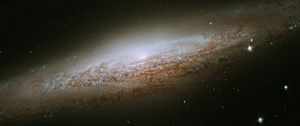- NGC 2683
-
NGC 2683 
NGC 2683 spiral galaxyObservation data (J2000 epoch) Constellation Lynx Right ascension 08h 52m 41.3s[1] Declination +33° 25′ 19″[1] Redshift 411 ± 1 km/s[1] Distance 25 ± 4 Mly (7.7 ± 1.3 Mpc)[2] Type SA(rs)b[1] Apparent dimensions (V) 9′.3 × 2′.2[1] Apparent magnitude (V) 10.6[1] Other designations UGC 4641,[1] PGC 24930[1] See also: Galaxy, List of galaxies NGC 2683 is an unbarred spiral galaxy discovered by William Herschel on February 5, 1788. It was nicknamed the "UFO Galaxy" by the Astronaut Memorial Planetarium and Observatory.[3] It is viewed nearly edge-on from Earth's location in space and is located between 16 to 25 million light-years away. It is receding from Earth at 410 km/s (250 mi/s), and from the Galactic Center at 375 km/s (233 mi/s).[3] The reddened light from the center of the galaxy appears yellowish due to the intervening gas and dust located within the outer arms of NGC 2683.[4]
References
- ^ a b c d e f g h "NASA/IPAC Extragalactic Database". Results for NGC 2683. http://nedwww.ipac.caltech.edu/. Retrieved 25 November 2006.
- ^ J. L. Tonry, A. Dressler, J. P. Blakeslee, E. A. Ajhar, A. B. Fletcher, G. A. Luppino, M. R. Metzger, C. B. Moore (2001). "The SBF Survey of Galaxy Distances. IV. SBF Magnitudes, Colors, and Distances". Astrophysical Journal 546 (2): 681–693. arXiv:astro-ph/0011223. Bibcode 2001ApJ...546..681T. doi:10.1086/318301.
- ^ a b "NGC 2683". http://www.seds.org/~spider/spider/Misc/n2683.html.
- ^ Matthews, Doug; Block, Adam (15 November 2004). "Best of AOP: NGC 2683". http://www.noao.edu/outreach/aop/observers/n2683.html. Retrieved 12 October 2010.
External links
- NGC 2683 on WikiSky: DSS2, SDSS, GALEX, IRAS, Hydrogen α, X-Ray, Astrophoto, Sky Map, Articles and images
Categories:- Spiral galaxies
- Unbarred spiral galaxies
- Lynx constellation
- NGC objects
- UGC objects
- PGC objects
Wikimedia Foundation. 2010.
